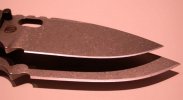Hello guys. If you had the option of opening a small side business for knife sharpening out of your home, what machine would you use? Would you go for Tormek T2, a Tru-Hone, or a Work Sharp Ken Onion? Or other? Any pros and cons of each?
I’m looking to sharpen knives only at this stage and not scissors or tools. I have a very small spare room in my apartment, so I need something practical as I don’t have a garage. Again this is for a small side business not full time, so will be targeting restaurants and some cafes. Any tips or recommendations are most welcome. Thank you!
I’m looking to sharpen knives only at this stage and not scissors or tools. I have a very small spare room in my apartment, so I need something practical as I don’t have a garage. Again this is for a small side business not full time, so will be targeting restaurants and some cafes. Any tips or recommendations are most welcome. Thank you!

